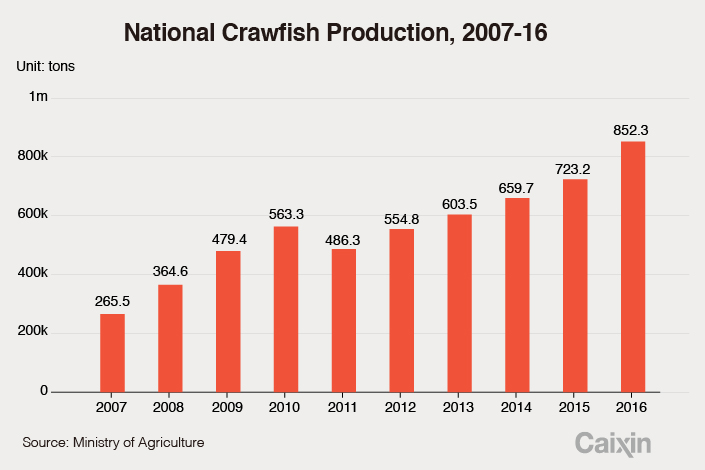China Caught in Claws of New Food Fad: Piping Hot Crawfish

(Beijing) — China’s voracious appetite for crawfish has spawned a multibillion-dollar industry and tripled production of farmed crawfish between 2007 and 2016 to 850,000 tons.
Total output of the freshwater crustacean, including those caught in the wild, reached 899,100 tons last year, and consumption rose by nearly one-third over the past two years to 879,300 tons in 2016.
The booming crawfish industry, valued at 146.6 billion yuan ($21.58 billion) last year, employed over 5 million people on fish farms and in food processing plants and restaurants serving only sizzling crawfish dishes, according to a report released by the Ministry of Agriculture on Monday.
Crawfish, also known as crayfish or freshwater lobster, is an alien species brought to China in the 1920s. They made their way from the U.S. — where they are a staple in Cajun cuisine in Louisiana — through Hawaii to Japan as food for bullfrogs in the early 1900s, and brought to Nanjing by traders in 1929, according to a 2015 article on World of Chinese, a website dedicated to Chinese literature and culture.
 |
Crawfish farmers in the central province of Hubei led the charge in farming the species, churning out 489,000 tons last year, or over 57% of the total output in China in 2016.
Four other provinces — Jiangxi, Anhui, Jiangsu and Hunan— came in second through fifth respectively in terms of crawfish output, accounting for more than 42% of the country’s production between them, the ministry said.
China’s restaurant-goers, especially young foodies, have found themselves in the claws of the crayfish mania that has swept across the country in recent years. In central Hubei province alone, over 15,000 exclusive restaurants are serving crawfish dishes, earning 33.3 billion yuan in total revenues last year, up by 30% from a year earlier, according to the report.
 |
Hubei Zhouheiya Co. Ltd., a food giant in the central city of Wuhan known for its cooked and marinated duck meat products, launched a unit to sell ready-to-eat crawfish products earlier this month in an attempt to carve out a slice of the growing crawfish pie.
However, the industry has been dogged by fears of potential health risks linked to consuming contaminated crawfish products.
More than a dozen Nanjing residents came down with Haff disease in 2010 allegedly after eating crawfish, local media reported, but government investigators later said they couldn’t link the infection to possible contamination in crawfish. One cause of Haff disease, an infection which causes muscle decay and could lead to kidney failure, is consuming fish contaminated by toxic chemicals.
The Agriculture Ministry said that improvements in five areas, including crawfish processing and disease control, were needed to ensure the healthy development of the industry.
Contact reporter Li Rongde (rongdeli@caixin.com)

- 1Cover Story: Chinese Medicine Injections Face Rigorous Regulation for the First Time
- 2France to Receive New Panda Pair Under Renewed 10-Year Deal With China
- 3 China Flu Cases Surge to Highest Level Since 2022
- 4Wingtech Rebuts Nexperia Claims as Control Fight Threatens Global Chip Supply
- 5BYD Overhauls Payment System as China Tightens Oversight
- 1Power To The People: Pintec Serves A Booming Consumer Class
- 2Largest hotel group in Europe accepts UnionPay
- 3UnionPay mobile QuickPass debuts in Hong Kong
- 4UnionPay International launches premium catering privilege U Dining Collection
- 5UnionPay International’s U Plan has covered over 1600 stores overseas





